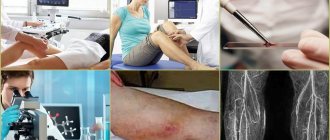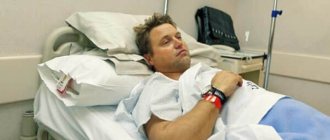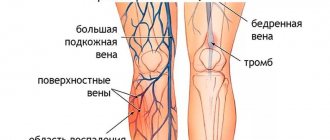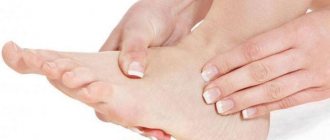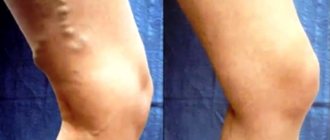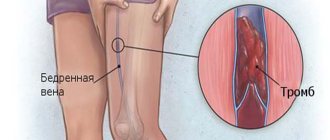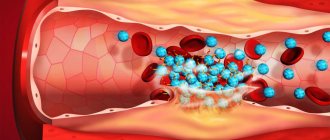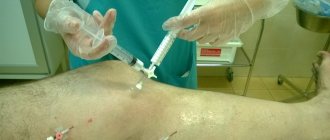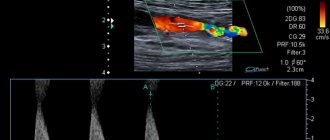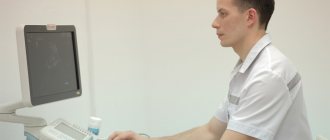Nutrition for thrombosis: general information
Patients, first of all, need to develop a new drinking regimen, in which the amount of liquid drunk (primarily water) should reach the established norm (1.5-2 l). Foods high in vitamins C and K should be removed from your daily diet.
Expert opinion
Treatment of thrombosis includes taking anticoagulants, in particular Warfarin. This drug involves following a strict diet that limits the amount of foods rich in vitamin K. First of all, green tea, spinach, lettuce, cabbage, and beef liver.
Vascular surgeon, phlebologist
Osipova Ekaterina Yakovlevna
Some healthy foods can only be eaten in limited quantities, since the vitamins in their composition not only have a beneficial effect and promote overall recovery, but also increase blood clotting, which is undesirable in this case. We are talking about lettuce leaves, rose hips, tomatoes, various types of cabbage, liver and other offal, currants. These foods should be limited in the diet until the risk of thrombosis is reduced.
Statistics on the localization of thrombotic lesions
Proper nutrition for thrombosis (Thrombosis) completely excludes smoked, salty, and sweet foods. The patient should consume more plant foods - vegetables, fruits, vegetable oils, legumes and grains. Many people are interested in whether it is possible to add vinegar to food, eat pepper and garlic, or hot horseradish, if the threat of disease is minimized? Doctors do not prohibit this food, but there is a taboo on alcoholic drinks and spicy foods.
The diet for thrombosis is based on a diet enriched with polyunsaturated fats, vitamin E and fiber. Preference should be given to steamed, stewed and boiled dishes. Products can also be sliced and baked. The amount of food of animal origin must be reduced.
What are the benefits of foods that are the main sources of fiber? Fresh vegetables and fruits improve the elasticity of the walls of blood vessels.
Diet recipes
For patients with thrombosis, there are many recipes that are not only healthy, but also tasty. They contain only approved products.
Patients prepare the following dishes:
- Cutlets. Beets and carrots are crushed using a grater and squeezed out so that there is not a lot of moisture. Then mixed with chopped onion. Take semolina, dilute it in water and add it to vegetables. Mix everything, add mashed potatoes and make cutlets. The dish is steamed.
- Carrot-apple salad. The products are passed through a grater, poured with olive oil and mixed.
- Fruit salad. Slice avocado, apple, kiwi, pour over low-fat yogurt.
- Soup with seafood. Shrimp are thrown into boiling water, cooked for a few minutes, then removed and peeled. Then they prepare chicken broth, add onions, radishes, and soybean shoots. 5 minutes before readiness add shrimp and herbs.
- Baked vegetables. Eggplants, zucchini, tomatoes are chopped, placed on a baking sheet, sprinkled with garlic and herbs on top. Then cover the vegetables with foil, place in the oven and bake for 20 minutes.
These dishes will provide the patient’s body with all useful substances, will help maintain normal blood vessels, improve blood counts, and increase immunity.
Nutrition for thrombosis: recommendations
Nutrition for vein thrombosis: what not to eat? First of all, you need to stop drinking coffee or alcohol regularly. Sausages, citrus fruits, baked goods, smoked meats, desserts, canned food, dairy products, and currants should disappear from the daily menu.
The deep vein thrombosis diet aims to reduce the consumption of foods that increase blood clotting rates. The patient must, on the contrary, strive to keep the blood liquid.
The diet is based on the consumption of lean meat, fresh vegetables and fruits. The foundation of the diet for vein thrombosis consists of products with Omega-3 and vitamin E.
!
Bakery products should be excluded from the diet.
Vitamin E prevents the breakdown of poly- and monounsaturated fats. It is taken in the form of capsules or tablets as part of a prescribed regimen. Vitamin E is also found in concentrated form in sunflower seeds, sesame and flax seeds, sprouted wheat sprouts, and avocados. Oils like flaxseed and olive are also useful, but only cold-pressed.
Saturated fats should be limited. If you have problems with blood vessels, you should eat chocolate (75% or more), lard, meat, high-fat hard cheeses, and butter. It will be difficult for the body to process these products compared to quickly digestible sugar, but this source of energy for the cell is much better.
Refined flour, sugar, carbonated drinks, sugary cereals and all other simple carbohydrates contribute to the accumulation of excess fat and fluctuations in blood glucose levels. The more sweets you eat, the more your blood viscosity increases, and this can lead to problems with blood clots.
Expert opinion
It is not recommended to abruptly stop eating foods that you ate before the onset of the disease. Instead, doctors recommend introducing new dietary rules gradually so that the body gets used to them and does not experience stress.
Vascular surgeon, phlebologist
Osipova Ekaterina Yakovlevna
Diet for thrombosis: menu
Food for thrombosis and varicose veins should be balanced and selected specifically to thin the blood. During an exacerbation of the disease, the diet is more strict, but on ordinary days you can eat the same food that is healthy for any healthy person.
Menu options for three days
First day. You can cook bran for breakfast. For an afternoon snack you can eat permitted fruits, at lunchtime - soup without fried vegetables (frying is allowed only in olive oil). In the evening, stewed vegetable stew and herbal decoction are offered.
Second day. You can have buckwheat porridge for breakfast. For a snack before lunch, fruits or steamed vegetables are suitable. For lunch you can eat fish soup, as well as berry jelly. Potatoes stewed with vegetables are suitable for dinner.
The third day. For breakfast you can make dark rice porridge and chicken breast. Nuts (cashews) are suitable for a snack, and a vegetable salad for lunch. For dinner, pumpkin stew with berries and a herbal drink are offered.
Approximate menu for several days
Eating habits form quickly, and it is quite difficult to give up your usual diet. A pre-prepared menu for the week helps to simplify the process, in which dishes for each meal will be precisely defined.
Monday
| Breakfast | Snack | Dinner | Afternoon snack | Dinner |
| Oatmeal with dried fruits, weak tea | Ryazhenka | Wheat porridge with lean boiled beef, vegetable salad | Raspberries or strawberries, low-fat kefir | Boiled chicken fillet, cucumber and tomato salad |
Tuesday
| Breakfast | Snack | Dinner | Afternoon snack | Dinner |
| Whole grain toast, lemon and ginger tea | Zucchini, baked or steamed | Baked fish, side dish of steamed vegetables | Ginger tea, dried fruits | Stewed vegetables, dried fruits or baked apple with honey |
Wednesday
| Breakfast | Snack | Dinner | Afternoon snack | Dinner |
| Oatmeal muesli with fresh berries | Citrus | Steamed chicken cutlets, porridge, vegetable salad | Vegetable salad with feta cheese | Boiled chicken, vegetable salad with flaxseed oil |
Thursday
| Breakfast | Snack | Dinner | Afternoon snack | Dinner |
| White bread toast, low-fat cheese, homemade compote | Vegetables cooked in a steamer | Vegetable soup, boiled chicken breast | Kefir or yogurt | Curd casserole with berries |
Friday
| Breakfast | Snack | Dinner | Afternoon snack | Dinner |
| Curd mass with dried fruits, kefir | Natural low-fat yogurt | Salmon or red fish soup, buckwheat with vegetables | Tea, crackers, dried fruits | Vegetables with fish, tomatoes and cucumbers |
Saturday
| Breakfast | Snack | Dinner | Afternoon snack | Dinner |
| Biscuits, tea | Baked vegetables | Buckwheat soup with vegetables and chicken, croutons | Sourdough or natural yogurt | Sandwich with feta cheese and tomato; vegetable stew |
Sunday
| Breakfast | Snack | Dinner | Afternoon snack | Dinner |
| Natural yogurt | Fresh fruits | Lenten soup; hard-boiled egg, black bread | Baked vegetables, kefir | Cottage cheese casserole with raisins |
It is recommended to cook food one time at a time. Several times a week you can use vegetable oil during cooking; preference should be given to flaxseed, sesame or olive oil. They also season salads: mayonnaise and store-bought sauces are prohibited.
Nutrition for deep vein thrombosis of the lower extremities
A diet for deep vein thrombosis of the lower extremities helps to lose weight, reduce blood viscosity, and improve stool. The vessels become cleaner, and their walls become more elastic. In general, metabolic processes in the body are activated.
!
The diet is drawn up by a doctor who prescribes medications and takes into account their compatibility.
The diet for problems with the veins of the lower extremities is introduced only for three to four weeks, and during this time a positive result can be achieved. Some products can reduce the effectiveness of selected medications.
The ratio of venous and arterial thrombosis
Nutrition for thrombosis of the lower extremities involves eating onions (raw or cooked), garlic, berries, ginger, fish oil, and vegetables. Lean meat (boiled or steamed) can be eaten three times a week.
!
It is necessary to completely exclude from the diet those foods that impair blood circulation, stagnation of venous blood occurs and blood clots form.
If you have problems with blood clots, you need to completely eliminate sugar, smoked foods, sweets, canned food, alcohol, juices, processed foods, and coffee.
To prevent diseases associated with the formation of blood clots, prevent congestion and improve blood circulation in the legs, you can use special creams and vitamin complexes.
Additional recommendations
To solve the problem of vascular blood clots, an integrated approach is required
Everything is important here: diet and medication. And lifestyle
The basic rules for ensuring the effectiveness of the treatment menu are as follows:
- refusal of hot showers and baths in favor of warm water;
- getting rid of bad habits, including drinking alcohol and smoking;
- sufficient fluid intake (preferably clean water) - about 1.5 liters per day, which helps eliminate waste and toxins from the body;
- ensuring physical activity - light, but regular exercise will prevent stagnation in the blood vessels;
- the right choice of clothing - it should not tighten parts of the body.
Diet for thrombosis of hemorrhoids
With such damage to these nodes, an adjusted food intake system should help improve intestinal motility and prevent constipation. It is very important that the stool is maintained normally. If the regimen is violated, the disease can progress to acute hemorrhoids (Haemorrois).
The diet requires sufficient fiber to regulate intestinal function. It is necessary to achieve lower cholesterol levels through foods with a high content of soluble plant fibers.
!
The menu should include legumes, offal, fruits and seaweed.
Pectin substances belong to the group of soluble substances. When dissolved, they swell and absorb toxins from the intestinal walls. Due to this, glucose absorption slows down, and as a result, blood sugar levels decrease. Microflora breaks down pectins in the large intestine, thereby ensuring the required level of acidity.
Diet for thrombosis: products
General rules
Nutrition for thrombophlebitis is aimed at:
- improvement of blood circulation processes;
- regulation of metabolism;
- prevention of fluid retention;
- improvement of the structure of venous walls;
- reducing stress on blood vessels;
- weight correction;
- normalization of bowel movements frequency;
- reduction of swelling;
- preventing the deposition of cholesterol plaques on vascular walls.
The diet is based on the rules of rational nutrition. If the patient suffers from increased weight, then first of all, therapeutic nutrition involves reducing body weight. If this is not done, the veins are subject to increased stress and the disease progresses.
With the development of obesity, the calorie content of the menu is reduced to 1700 kcal. It is regulated by limiting the amount of easily digestible animal fats and carbohydrates. Proteins, especially essential ones, are not limiting. If the patient suffers from increased body weight, then a fasting day is arranged once every 7 days. On this day, the patient eats either one product (mono-diet) or includes several low-calorie foods in his menu. The number of meals on this day increases to 7.
Patients with thrombophlebitis often suffer from constipation. Because of this, intra-abdominal pressure greatly increases and chronic venous insufficiency progresses. To normalize stool, plant fiber is introduced (vegetables, bran bread, fresh fruits).
If the patient has a normal weight, then the basis of his diet is protein, cereals, vegetables and fruits. It is important that the menu contains a sufficient amount of protein foods.
The diet of a person suffering from thrombophlebitis must constantly include dishes that improve blood clotting characteristics. These include:
- fish;
- seafood;
- milk fermentation products;
- some berries.
In addition, seafood promotes the synthesis of collagen, which gives strength and elasticity to the venous walls.
To normalize blood microcirculation and strengthen the wall, antioxidants and flavonoids (ascorutin, silymarin, quercetin) are useful. They are found in citrus fruits, natural black tea, red fruits and vegetables, and grape juice.
Important information: How to treat thrombophlebitis of the lower extremities and modern methods for diagnosing blockage of veins in the legs
Diet with vein damage always involves limiting salt intake. A low-salt diet is prescribed to all patients suffering from increased body weight. Provided there is no tendency to edema, the patient drinks a sufficient amount of water - at least 2 liters during the day. To reduce the risk of thrombus formation (blood clots), foods rich in vikasol - vitamin K are not allowed. These are spinach, seaweed, liver, cauliflower and kale, and watercress.
If there is an increased risk of blood clots, all patients are regularly tested for platelet levels in their blood. If you are overweight, you must adhere to a meal plan, avoid overeating and long breaks in eating.
Products
The patient is prescribed food containing polyunsaturated fats. Ideal products in this regard are fish oil and flaxseed oil. The minimum consumption of fish is twice weekly. The diet must include trout, herring, mackerel and other fish caught in the natural environment.
What you can eat:
- the consumption of legumes, sunflower seeds, pumpkin dishes is allowed,
- dried fruits,
- Herbal infusions (chamomile, nettle) have a beneficial effect on the body in case of the disease in question,
- When choosing tea, give preference to green.
What other foods should the patient eat? Vegetable soup, potatoes, vegetables, berries and fruits will have a positive effect on your health. Garlic, onions, avocado and sprouted wheat should also be included in the mandatory list of products.
List of products prohibited for varicose veins and thrombophlebitis
1. All flour and sweets, alcoholic drinks (especially beer), smoked products and meat broths; pickles and marinades. They increase the load on the kidneys because they retain water in the body. Fatty and rich foods significantly worsen the functioning of blood vessels (veins). Do not allow stress on the entire body and legs.
2. Canned goods and jellies.
3. Black tea and coffee. If it is impossible for you to completely give up these products, reduce their consumption to a minimum - no more than two cups per day and always with milk.
4. Due to the fact that table salt negatively affects the rheological properties of blood, salt your food very moderately.
When strict adherence to rules is required
A strict diet is provided only for a limited period of time - during exacerbation of the disease. When the condition returns to normal, you can begin to expand the menu, but not violate the principles of a balanced diet.
If you follow the advice properly and choose only healthy foods, you can significantly improve your condition after illness and feel how your quality of life has changed for the better.
In addition to the treatment prescribed by the phlebologist, diet and lifestyle correction, Normaven® products can be used as an additional remedy for thrombosis. Systematic use of the Cream and Tonic for the legs can reduce the symptoms of the disease, relieve fatigue and a feeling of heaviness in the lower extremities, minimize swelling and cramps, and reduce the intensity of the vascular pattern. Clinical studies of Normaven® Foot Cream have proven that these results can be achieved within a 3-month course of use. Normaven® cream and tonic were developed by specialists from the pharmaceutical company VERTEX and have the necessary documents and certificates.
Which shoes to choose?
In case of thrombosis and thrombophlebitis, doctors give recommendations to prevent relapses or progression of the disease. One of the points is wearing comfortable shoes. But no one tells you how to choose it correctly. When purchasing new boots or shoes, consider the following points:
- Try on a new pair of shoes in the evening, as your feet swell and increase in volume.
- You should forget about tight shoes and do not listen to the advice of sellers that the shoes will stretch over time. My legs are already hurting, why aggravate the condition.
- Give preference to lace-up shoes. This will help you adjust it individually to your foot.
- Avoid high heels. A heel of no more than four centimeters is considered physiologically comfortable. Anything higher impairs blood circulation and leads to more pronounced swelling.
- Choose models made from natural materials.
- Feet can be different sizes. It's okay to be a little asymmetrical, but you should choose shoes that fit your larger foot.
Don't neglect your health for the sake of beauty or fashion. Give preference to high-quality and comfortable shoes.
